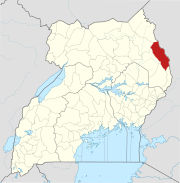Moroto Cement Limited
 From Wikipedia the free encyclopedia
From Wikipedia the free encyclopedia
| Company type | Private |
|---|---|
| Industry | Manufacture of Construction Materials |
| Founded | 2012 |
| Headquarters | Moroto, Uganda |
Key people | Raza Ghulam Chairman Michael Mawanda Muranga Executive Director |
| Products | Cement |
Moroto Cement Limited (MCL), whose full name is Moroto Cement Industries Limited, is a manufacturer of cement in Uganda with approximately 3000 tonnes per day clinker capacity.[1]
Location[edit]
It was expected that when construction would be completed in 2013, the main factories of the company would be located in Lorukumoi Village, in Rupa Sub-county, in Moroto District, Karamoja sub-region, in Northeastern Uganda. This location lies near the town of Moroto, approximately 460 kilometres (286 mi), by road, northeast of Kampala, the capital of Uganda and the largest city in that country.[2] This location lies approximately 313 kilometres (194 mi), by road, east of the city of Gulu, the largest urban center in Northern Uganda.[3]
Overview[edit]
With an estimated production capacity of 1,000,000 metric tonnes annually, Moroto Cement Limited is expected to be one of the largest manufacturers of cement in Uganda, accounting for about 34 percent of annual national output. Tororo Cement Limited, accounts for another 34 percent.[4]
Hima Cement Limited, which produces an estimated 850,000 metric tonnes annually, accounts for the remaining 32 percent.[5] The bulk of MCL's output is expected to go towards the construction of Karuma Power Station, the largest hydro-power station ever undertaken in Uganda's history. As of November 2013[update], production capacity at the factory in Moroto was estimated at 3,000 metric tonnes daily.[6]
History[edit]
The company was established in 2012. It has carried out feasibility studies on limestone deposits in Moroto District, finding sufficient quantities to last 100 years at maximum production capacity. Construction of the main factory was expected to begin in late 2012 and last approximately one year. Commercial production of cement was expected to begin soon after the factory was commissioned. Start-up costs were estimated at UGX:1 trillion (about US$400 million at that time).[1]
Cancellation of license[edit]
In March 2017, the Uganda Radio Network, a news agency, reported that the Directorate of Geological Survey and Mines in the Uganda Ministry of Energy and Mineral Development had cancelled the mining license of Moroto Cement Industries Limited, the owner/developers of this project. The reason for the cancellation was given as "failure to start development", four years after being awarded a licence.[7]
See also[edit]
References[edit]
- ^ a b Ariong, Steven (3 October 2012). "Karamoja to get cement factory". Daily Monitor. Kampala. Retrieved 26 June 2018.
- ^ Globefeed.com (26 June 2018). "Distance between Post Office Building, Kampala Road, Kampala, Uganda and Rupa Health Center, Uganda". Globefeed.com. Retrieved 26 June 2018.
- ^ Globefeed.com (26 June 2018). "Distance between Gulu Post Office, Gulu, Uganda and Rupa Health center, Uganda". Globefeed.com. Retrieved 26 June 2018.
- ^ Mugabe, David (10 September 2014). "CMA to discuss funding options at oil and minerals meet". New Vision. Kampala. Retrieved 26 June 2018.
- ^ Press Release (30 July 2010). "Hima Cement New Factory Moves Uganda To Self Sufficiency In Cement Production". Hima, Kasese District, Uganda: Hima Cement Limited. Archived from the original (Archived from the Original) on 11 July 2011. Retrieved 26 June 2018.
- ^ "Low activity reduces input prices in construction sector". Daily Monitor. Kampala. 26 November 2013. Retrieved 26 June 2018.
- ^ Eninu, Edward (30 March 2017). "Moroto Cement License Cancelled". Kampala: Uganda Radio Network. Retrieved 26 June 2018.
